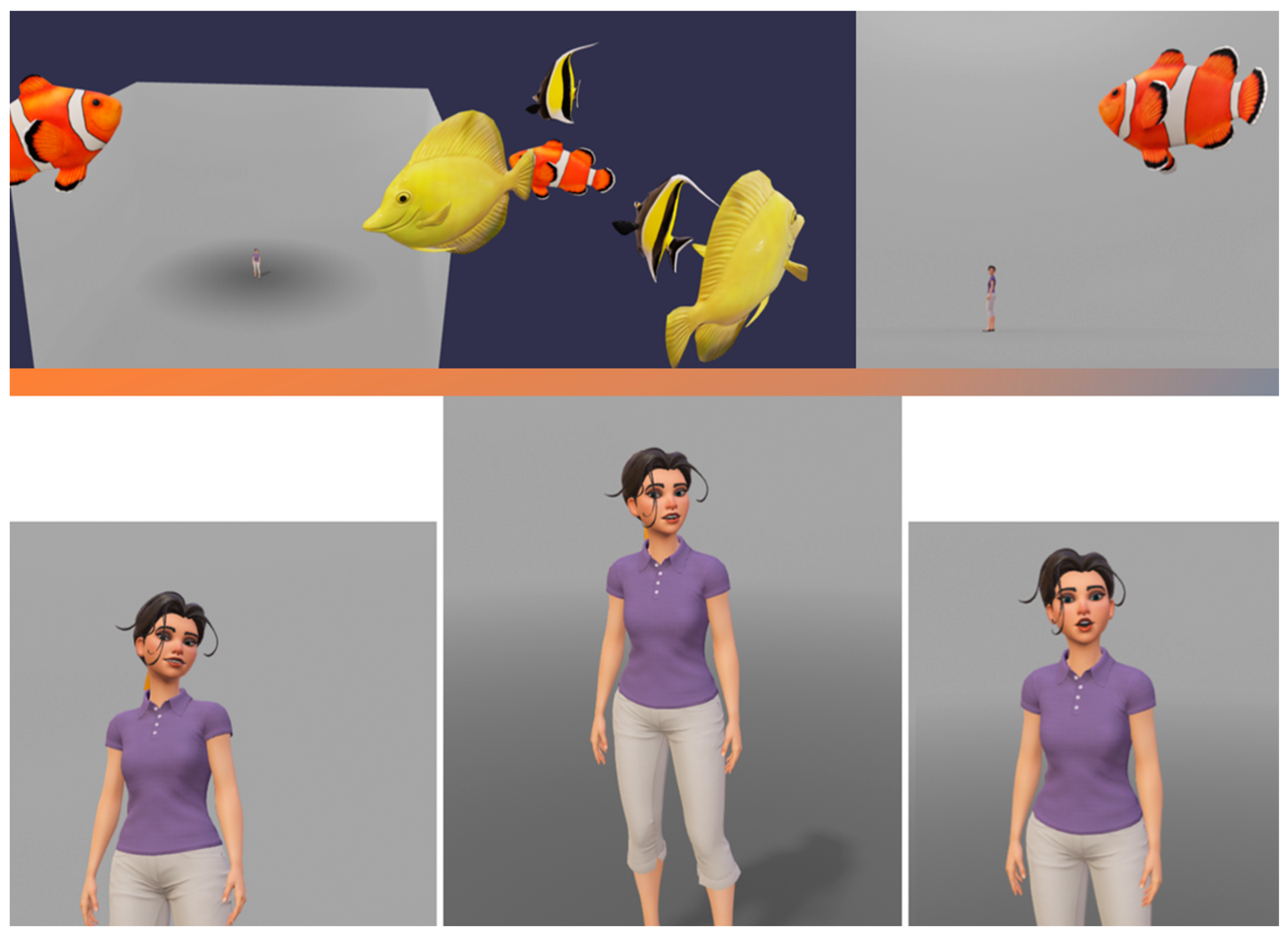vFerryman: An Artificial Intelligence-Driven Personalized Companion Providing Calming Visuals and Social Interaction for Emotional Well-Being †
Abstract
1. Introduction
2. vFerryman System
3. Conclusions
4. Future Outlook
Funding
Institutional Review Board Statement
Informed Consent Statement
Data Availability Statement
Acknowledgments
Conflicts of Interest
References
- Martinengo, L.; Lum, E.; Car, J. Evaluation of chatbot-delivered interventions for self-management of depression: Content analysis. J. Affect. Disord. 2022, 319, 598–607. [Google Scholar] [CrossRef] [PubMed]
- Zhang, J.J. See You Tomorrow [Film]; Alibaba Pictures: Shanghai, China, 2016. [Google Scholar]
- Amazon. Amazon Sumerian. Amazon Web Services. Available online: https://aws.amazon.com/sumerian/ (accessed on 13 November 2024).
- Babylon.js. Welcome to Babylon.js 5.0. Available online: https://www.babylonjs.com/ (accessed on 13 November 2024).
- Aggarwal, A.; Tam, C.C.; Wu, D.; Li, X.; Qiao, S. Artificial intelligence–based chatbots for promoting health behavioral changes: Systematic review. J. Med. Internet Res. 2023, 25, e40789. [Google Scholar] [CrossRef] [PubMed]
- Boucher, E.M.; Harake, N.R.; Ward, H.E.; Stoeckl, S.E.; Vargas, J.; Minkel, J.; Zilca, R. Artificially intelligent chatbots in digital mental health interventions: A review. Expert Rev. Med. Devices 2021, 18 (Suppl. 1), 37–49. [Google Scholar] [CrossRef] [PubMed]
- Omarov, B.; Narynov, S.; Zhumanov, Z. Artificial Intelligence-Enabled Chatbots in Mental Health: A Systematic Review. Comput. Mater. Contin. 2023, 74, 5105–5122. [Google Scholar] [CrossRef]
- Bhatt, S. Digital Mental Health: Role of Artificial Intelligence in Psychotherapy. Ann. Neurosci. 2024. [Google Scholar] [CrossRef] [PubMed]
- Gutierrez, G.; Stephenson, C.; Eadie, J.; Asadpour, K.; Alavi, N. Examining the role of AI technology in online mental healthcare: Opportunities, challenges, and implications, a mixed-methods review. Front. Psychiatry 2024, 15, 1356773. [Google Scholar] [CrossRef] [PubMed]
- Minerva, F.; Giubilini, A. Is AI the future of mental healthcare? Topoi 2023, 42, 809–817. [Google Scholar] [CrossRef] [PubMed]
- Gamble, A. Artificial intelligence and mobile apps for mental healthcare: A social informatics perspective. Aslib J. Inf. Manag. 2020, 72, 509–523. [Google Scholar] [CrossRef]
- Brown, J.E.; Halpern, J. AI chatbots cannot replace human interactions in the pursuit of more inclusive mental healthcare. SSM-Mental Health 2021, 1, 100017. [Google Scholar] [CrossRef]
- Dakanalis, A.; Wiederhold, B.K.; Riva, G. Artificial intelligence: A game-changer for mental health care. Cyberpsychol. Behav. Soc. Netw. 2024, 27, 100–104. [Google Scholar] [CrossRef] [PubMed]
- Chen, T. Challenges and Opportunities in Integrating LLMs into Continuous Integration/Continuous Deployment (CI/CD) Pipelines. In Proceedings of the 2024 5th International Seminar on Artificial Intelligence, Networking and Information Technology (AINIT), Nanjing, China, 29–31 March 2024; pp. 364–367. [Google Scholar]
- Huang, K.; Manral, V.; Wang, W. From LLMOps to DevSecOps for GenAI. In Generative AI Security: Theories and Practices; Springer Nature: Cham, Switzerland, 2024; pp. 241–269. [Google Scholar]
- Diaz-De-Arcaya, J.; López-De-Armentia, J.; Miñón, R.; Ojanguren, I.L.; Torre-Bastida, A.I. Large Language Model Operations (LLMOps): Definition, Challenges, and Lifecycle Management. In Proceedings of the 2024 9th International Conference on Smart and Sustainable Technologies (SpliTech), Bol and Split, Croatia, 25–28 June 2024; pp. 1–4. [Google Scholar]
- Shi, C.; Liang, P.; Wu, Y.; Zhan, T.; Jin, Z. Maximizing User Experience with LLMOps-Driven Personalized Recommendation Systems. arXiv 2024, arXiv:2404.00903. [Google Scholar] [CrossRef]
- Berti, A.; Maatallah, M.; Jessen, U.; Sroka, M.; Ghannouchi, S.A. Re-Thinking Process Mining in the AI-Based Agents Era. arXiv 2024, arXiv:2408.07720. [Google Scholar]
- Pradas Gomez, A.; Panarotto, M.; Isaksson, O. Evaluation of Different Large Language Model Agent Frameworks for Design Engineering Tasks. In DS 130: Proceedings of NordDesign 2024, Reykjavik, Iceland, 12–14 August 2024; Chalmers University of Technology: Göteborg, Sweden, 2024; pp. 693–702. [Google Scholar]
- Liu, Z.; Yao, W.; Zhang, J.; Yang, L.; Liu, Z.; Tan, J.; Savarese, S. AgentLite: A Lightweight Library for Building and Advancing Task-Oriented LLM Agent System. arXiv 2024, arXiv:2402.15538. [Google Scholar]
- Wray, R.E.; Kirk, J.R.; Laird, J.E. Eliciting Problem Specifications via Large Language Models. arXiv 2024, arXiv:2405.12147. [Google Scholar]
- Liu, Y.; Lo, S.K.; Lu, Q.; Zhu, L.; Zhao, D.; Xu, X.; Whittle, J. Agent Design Pattern Catalogue: A Collection of Architectural Patterns for Foundation Model Based Agents. arXiv 2024, arXiv:2405.10467. [Google Scholar] [CrossRef]
- Wang, W.J.; Lain, W.D.; Wang, Y.S. Empowering IT Maintenance with Human-AI Collaboration for Cloud Native. In Proceedings of the 2024 IEEE 4th International Conference on Electronic Communications, Internet of Things and Big Data (ICEIB), Taipei, Taiwan, 19–21 April 2024; pp. 80–82. [Google Scholar]

Disclaimer/Publisher’s Note: The statements, opinions and data contained in all publications are solely those of the individual author(s) and contributor(s) and not of MDPI and/or the editor(s). MDPI and/or the editor(s) disclaim responsibility for any injury to people or property resulting from any ideas, methods, instructions or products referred to in the content. |
© 2025 by the author. Licensee MDPI, Basel, Switzerland. This article is an open access article distributed under the terms and conditions of the Creative Commons Attribution (CC BY) license (https://creativecommons.org/licenses/by/4.0/).
Share and Cite
Wang, W.-J. vFerryman: An Artificial Intelligence-Driven Personalized Companion Providing Calming Visuals and Social Interaction for Emotional Well-Being. Eng. Proc. 2025, 92, 22. https://doi.org/10.3390/engproc2025092022
Wang W-J. vFerryman: An Artificial Intelligence-Driven Personalized Companion Providing Calming Visuals and Social Interaction for Emotional Well-Being. Engineering Proceedings. 2025; 92(1):22. https://doi.org/10.3390/engproc2025092022
Chicago/Turabian StyleWang, Wei-Ji. 2025. "vFerryman: An Artificial Intelligence-Driven Personalized Companion Providing Calming Visuals and Social Interaction for Emotional Well-Being" Engineering Proceedings 92, no. 1: 22. https://doi.org/10.3390/engproc2025092022
APA StyleWang, W.-J. (2025). vFerryman: An Artificial Intelligence-Driven Personalized Companion Providing Calming Visuals and Social Interaction for Emotional Well-Being. Engineering Proceedings, 92(1), 22. https://doi.org/10.3390/engproc2025092022





